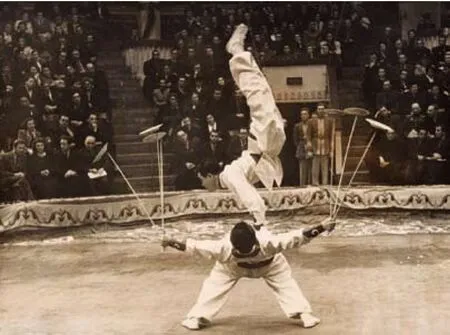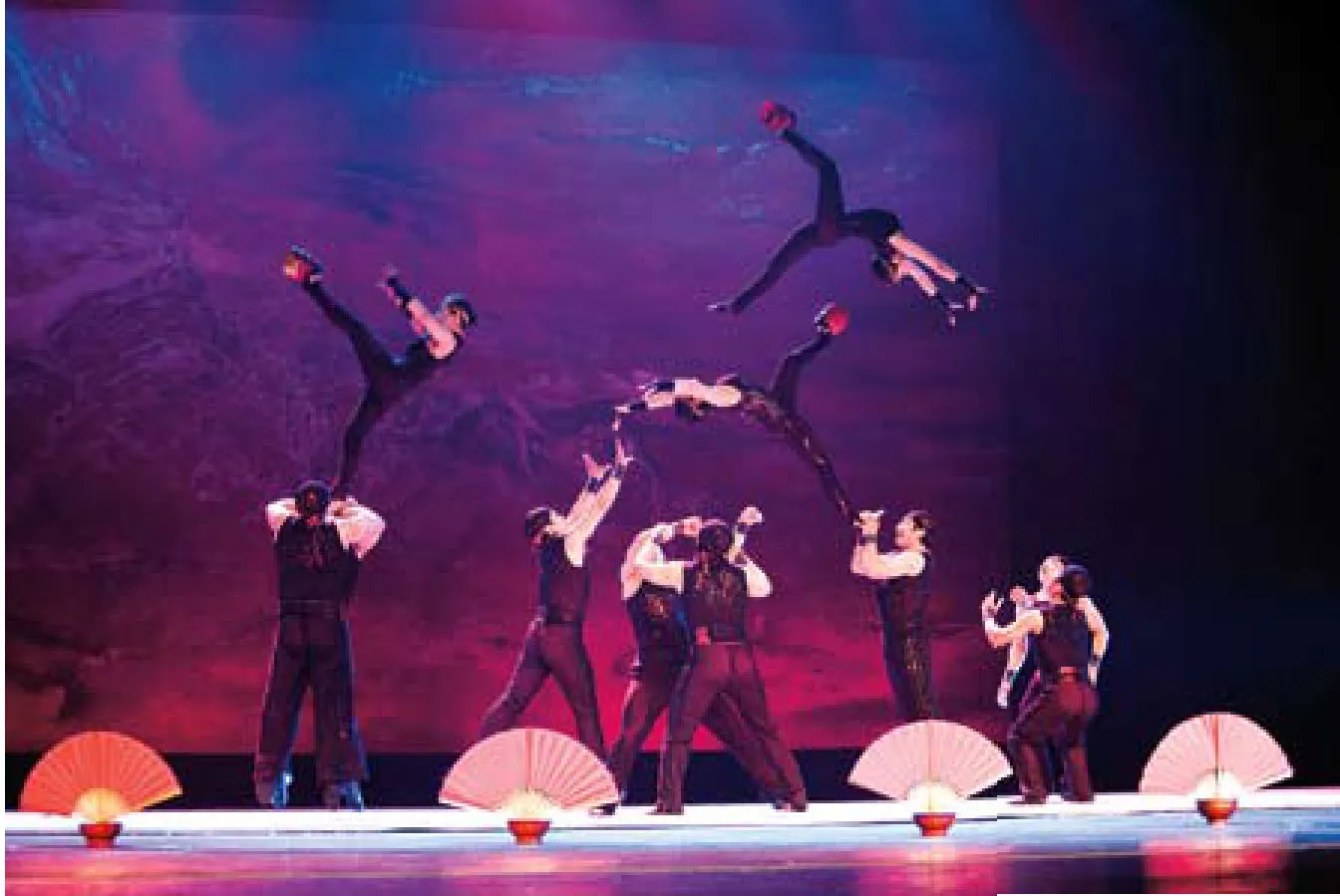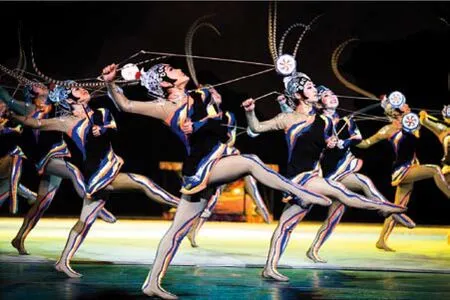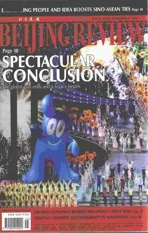Dream Team of Chinese Acrobatics
2010-10-14ByTANGYUANKAI
By TANG YUANKAI
Dream Team of Chinese Acrobatics
By TANG YUANKAI
The six-decade journey of an acrobatic troupe
On October 28, the China National Acrobatic Troupe (CNAT) and the Beijing International Art School (BIAS) opened the gate of their mysterious headquarters, inviting the public to become better acquainted with the acrobats’ lives behind the scenes.
Although those visitors know that as many as 10 years of off-stage practice are required for one minute of success on the stage, most of them were still greatly impressed by the training life of acrobats. They came to know how hard the acrobats have trained to win thundering applauses and awards, including 48 gold medals and four gold honor awards—both at home and abroad—in the last 60 years.
Making a figure
In 1950, Chinese artists were invited to perform in the former Soviet Union. Acrobats were members of the Chinese art delegation. Based on the visiting group of acrobats, CNAT, the frst national acrobatic troupe of China, was founded on October 20 that year.
Moscow film studios also made the grand performance into a documentary flm, which was shown in the former Soviet Union and Eastern European countries in 1951. Meanwhile, in China, the film set the bar for Chinese acrobatics. Encouraged by the successful performance, many Chinese provinces and municipalities began to establish provincial acrobatic troupes.
In recent years, many international events held in China, including the Beijing Olympic Games and the World Expo in Shanghai, were graced with a CNAT performance. In 60 years, CNAT has visited 118 countries and regions around the world; Chinese acrobatics has been the most frequently performed art in cultural exchanges between China and foreign countries.
Chinese acrobatics is said to trace back to 2,500 years ago. “Through acrobatics, one can achieve a deeper understanding of China,” said Dominique Mauclair, founder of the French International Circus Festival of Tomorrow.
He is very interested in Chinese acrobatics and its long history, and affrms the Chinese Government’s strong support for acrobatics. In his view, China is the paradise of acrobatics. The government, the public and the artists all attach great importance to the development of acrobatics. In recent years, Chinese acrobats have made substantial progress in traditional acrobatic skills, music, costumes, props, lighting and stage effects. The integration of art and skills improve, and Chinese acrobatics became flled with a unique charm, an ethnic style and a modern favor.
In 1956, Mauclair, then a journalist, watched a Chinese acrobatic show for the frst time, deeply fascinated by the excellent performance. In 1978, during his frst visit to China, he watched an acrobatic show in a small theater. When he saw the youngest actor was just 2 years old, while the oldest was over 70, he was amazed and struck with a feeling of novelty. At that moment, he was deeply impressed by the charm of Chinese acrobatics and decided to introduce Chinese acrobatics to the world.
Through his efforts, Chinese acrobatic troupes started performing in the International Circus Festival of Tomorrow, and won awards again and again. After that, modern Chinese acrobatics began to truly emerge on the world stage. Mauclair was thus regarded as having built the bridge between Chinese acrobatics and the world people.
Toward success
CNAT attached great importance to the innovation of acrobatic shows. The acrobats ceaselessly challenged physical limitations while repeatedly completing seemingly impossible tasks.

COURTESY OF ChINA NATIONAL ACROBATIC TROUPE

SENSATIONAL: The breathtaking Chinese acrobatic show Buckjumps and Rhythm—Pagoda of Bowls won the Golden Clown Award at the 28th International Circus Festival of Monte-Carlo in 2004
In each show, CNAT acrobats would try to reach new heights of performance. They not only complete the tasks, but do so with beauty. This can only be achieved after thousands of failures in training.
In 2004, when CNAT was invited to take part in the International Circus Festival of Monte-Carlo, then Vice President of CNAT Sun Lili had a bold idea. Sun’s idea broke the traditional act of balancing bowls on the head, a unique skill in Chinese acrobatics that was performed as far back as 2,000 years ago. Since then, shows have evolved from one-acrobat shows into multiple-acrobat performances, and the participants can both perform on the ground or in the air. However, Sun’s new idea immensely increased the diffculty of the show. An acrobat frst balances the bowls on her feet. As another performer tosses her in the air, she continues to balance the stack of bowls.
Initially, even Sun’s colleagues thought the idea was crazy, but eventually Sun persuaded them to try. As imagined, the training was extraordinarily diffcult in the beginning. Within two weeks, however, coach Li Genxi, a veteran of acrobatics at CNAT, successfully worked out fve sets of action designs after comprehensively considering the difficulty and coordination of the act. The diffculty of the show, played by 13 actors, was unprecedented. Generally, an acrobatic show needs several years of practice, but performers in this show,Buckjumps and Rhythm—Pagoda of Bowls, practiced for only 10 months.
In order to make the show more artistic, Sun invited the famous choreographer Zhang Jigang, Vice General Director of the opening and closing ceremonies of the Beijing Olympic Games, to create an eight-minute dance for it. Merged into graceful dance, the breathtaking performance won the Golden Clown Award, recognized as the acrobatic equivalent of an Oscar, at the International Circus Festival of Monte-Carlo that year.
Reform for tomorrow
At the end of 2006, a market-oriented reform was carried out in CNAT. “The old management regime seriously affected the development of the troupe. After reforming, the most urgent problems for us are how to create our own brand and how to develop Chinese acrobatics through market operations,” said Li Enjie, then President of CNAT. Li believed that excellent performers were the basis of an acrobatic troupe. Before the reform, the troupe seemed to have become a provider of skilled performers for foreign acrobatic troupes.
“CNAT has performed a lot in foreign countries, but most of our performances were only in low-end markets. We should change. We should begin by enlarging the domestic market, improving the quality and building a brand,” Li said.
As an enterprise, CNAT knows its production should meet the needs of its audiences and that modern business management was necessary. Thus, those who are good at market operation of cultural products have been introduced to the management team, including the well-known Chinese movie maker Feng Xiaogang.
On December 17, 2009,Goodbye, UFO, a three-dimensional musical acrobatic show created by CNAT, completely changed audiences’ impressions of traditional Chinese acrobatics.
“It is really unbelievable that acrobatics can be so marvelous and vogue,” said Yi Nan, a 25-year-old Beijing resident.
However, an older audience member seemed to disapprove of the performance, telling Li that he preferred “pure acrobatics.”
Obviously, the new performance won’t suit everyone’s taste, Li said. The target audience forGoodbye, UFOis indeed different. At present, CNAT is attempting to make a breakthrough, creating different styles for different audiences.
“If acrobatic shows were unable to attract young audiences, we would have trouble in development,” Li said.
Both music and technological means were utilized in the creation of new products. The reason Chinese acrobatics has been in existence for nearly 3,000 years is it has combined the most fashionable types of performing arts in each period of its development, Li said.
However, Li thinks the true vitality of acrobatics is still innate. “How to innovate around the acrobatic art itself is the most important issue for the development of Chinese acrobatics.
Currently, we must try to attract audiences to acrobatics theaters and then create new programs according to their needs. The purpose is to make the audience like it,” Li said.

COURTESY OF ChINA NATIONAL ACROBATIC TROUPE
